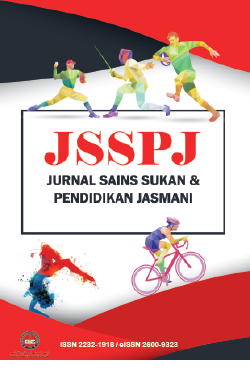Effect of Hot Water Immersion and Contrast Water Therapy on Markers of Exercise Induced Muscle Soreness Among University Football Players
DOI:
https://doi.org/10.37134/jsspj.vol12.2.2.2023Keywords:
Hot Water Immersion (HWI), Contrast Water Therapy (CWT), Pain Scale, ROMAbstract
Delayed-onset muscular soreness (DOMS), the sensation of pain and stiffness in the muscles that occurs 1 to 5 days after unaccustomed exercise would have negative effect on muscular performance. It was suggested that hot water immersion (HWI) may help with faster strength recovery, but more research is needed to prove this. Similarly, contrast water therapy (CWT) have potential for improving performance recovery, but further investigation is necessary. The purpose of this study is to investigate the effects of HWI and CWT on muscle soreness in university football players after a match. This quasi-experimental study involved eleven (N=11) participants that were assigned to underwent HWI and CWT. The participants immersed their lower body for 20 minutes in hot water immersion (40-42°C) while for contrast water therapy, the participants were immersing their lower body in hot water (40-42°C) for 1 minute, followed by cold water (14-16°C) for 1 minute with total of 3 cycles. The participant’s pain scale and ROM were recorded at four time periods which were immediately after match, 24 hours, 48 hours, and 72 hours after match. The effects in muscle soreness scores between the two groups were analyzed using repeated measure ANOVA. The results indicated that both CWT and HWI had a significant effect on pain scale (PS) and range of motion (ROM) between the four-time period (p<0.05). However, there is no significant difference in effect between HWI and CWT. Conclusions: In conclusion, HWI and CWT are effective to reduce muscle soreness among football players.
Downloads
References
Argus, C. K., Broatch, J. R., Petersen, A. C., Polman, R., Bishop, D. J., & Halson, S. (2017). Cold-water immersion and contrast water therapy: No Improvement of short-term recovery after resistance training. International Journal of Sports Physiology and Performance, 12(7), 886–892. https://doi.org/10.1123/ijspp.2016-0127
Armstrong, R. B. (1984). Mechanisms of exercise-induced delayed onset muscular soreness: a brief review. Medicine and Science in Sports and Exercise, 16(6), 529–538. https://europepmc.org/article/med/6392811
Atkinson, P. R. T. (2006). Is hot water immersion an effective treatment for marine envenomation? Emergency Medicine Journal, 23(7), 503–508. https://doi.org/10.1136/emj.2005.028456
Baker, L., Rollo, I., Stein, K., & Jeukendrup, A. (2015). Acute effects of carbohydrate supplementation on intermittent sports performance. Nutrients, 7(7), 5733–5763. https://doi.org/10.3390/nu7075249
Beever, R. (2010). The effects of repeated thermal therapy on quality of life in patients with type II diabetes mellitus. The Journal of Alternative and Complementary Medicine, 16(6), 677–681. https://doi.org/10.1089/acm.2009.0358
Cochrane, D. J. (2004). Alternating hot and cold water immersion for athlete recovery: A review. Physical Therapy in Sport, 5(1), 26–32. https://doi.org/10.1016/j.ptsp.2003.10.002
Delgado, D. A., Lambert, B. S., Boutris, N., McCulloch, P. C., Robbins, A. B., Moreno, M. R., & Harris, J. D. (2018). Validation of digital visual analog scale pain scoring With a traditional paper based visual analog scale in adults. JAAOS: Global Research and Reviews, 2(3), e088. https://doi.org/10.5435/JAAOSGlobal-D-17-00088
Dos Santos, R. A., Derhon, V., Brandalize, M., Brandalize, D., & Rossi, L. P. (2017). Evaluation of knee range of motion: Correlation between measurements using a universal goniometer and a smartphone goniometric application. Journal of Bodywork and Movement Therapies, 21(3), 699–703. https://doi.org/10.1016/j.jbmt.2016.11.008
Elias, G. P., Wyckelsma, V. L., Varley, M. C., McKenna, M. J., & Aughey, R. J. (2013). Effectiveness of water immersion on post-match recovery in elite professional footballers. International Journal of Sports Physiology and Performance, 8(3), 243–253. https://doi.org/10.1123/ijspp.8.3.243
Hoff, J., & Helgerud, J. (2004). Endurance and strength training for soccer players. Sports Medicine, 34(3), 165–180. https://doi.org/10.2165/00007256-200434030-00003
Malanga, G. A., Yan, N., & Stark, J. (2015). Mechanisms and efficacy of heat and cold therapies for musculoskeletal injury. Postgraduate Medicine, 127(1), 57–65. https://doi.org/10.1080/00325481.2015.992719
Miranda-Comas, G., Zaman, N., Ramin, J., & Gluck, A. (2022). The role of workload management in injury prevention, athletic, and academic performance in the student athlete. Current Sports Medicine Reports, 21(6), 186–191. https://doi.org/10.1249/JSR.0000000000000964
Nahon, R. L., Silva Lopes, J. S., & Monteiro de Magalhães Neto, A. (2021). Physical therapy interventions for the treatment of delayed onset muscle soreness (DOMS): Systematic review and meta-analysis. Physical Therapy in Sport, 52, 1–12. https://doi.org/10.1016/j.ptsp.2021.07.005
Ślaga, J., Gizińska, M., Rutkowski, R., Rąglewska, P., Balkó, Š., & Straburzyńska-Lupa, A. (2018). Using hydrotherapy at different temperatures for promoting recovery in professional athletes. Trends in Sport Sciences, 25(2), 57–67. https://doi.org/10.23829/TSS.2018.25.2-1
Vaile, J. M., Gill, N. D., & Blazevich, A. J. (2007). The effect of contrast water therapy on symptoms of delayed onset muscle soreness. The Journal of Strength and Conditioning Research, 21(3), 697. https://doi.org/10.1519/R-19355.1
Van Hooren, B., & Peake, J. M. (2018). Do we need a cool-down after exercise? A narrative review of the psychophysiological effects and the effects on performance, injuries and the long-term adaptive Response. Sports Medicine, 48(7), 1575–1595. https://doi.org/10.1007/s40279-018-0916-2
Versey, N. G., Halson, S. L., & Dawson, B. T. (2013). Water immersion recovery for athletes: Effect on exercise performance and practical recommendations. Sports Medicine, 43(11), 1101–1130. https://doi.org/10.1007/s40279-013-0063-8
Wilcock, I. M., Cronin, J. B., & Hing, W. A. (2006). Water immersion: Does it enhance recovery from exercise? International Journal of Sports Physiology and Performance, 1(3), 195–206. https://doi.org/10.1123/ijspp.1.3.195
Nahon, R. L., Silva Lopes, J. S., & Monteiro de Magalhães Neto, A. (2021). Physical therapy interventions for the treatment of delayed onset muscle soreness (DOMS): Systematic review and meta-analysis. Physical Therapy in Sport, 52, 1–12. https://doi.org/10.1016/j.ptsp.2021.07.005
Wang, Y., Lu, H., Li, S., Zhang, Y., Yan, F., Huang, Y., Chen, X., Yang, A., Han, L., & Ma, Y. (2022). Effect of Cold and Heat Therapies on Pain Relief in Patients With Delayed Onset Muscle Soreness: a Network Meta-Analysis. Journal of Rehabilitation Medicine, 54. https://doi.org/10.2340/jrm.v53.331
Downloads
Published
How to Cite
Issue
Section
License
Copyright (c) 2023 Muhamad Shafiq Izaan Azman, Mardiana Mazaulan, Muhamad Noor Mohamed, Raja Nurul Jannat Raja Hussein, Sharifah Maimunah Syed Mud Puad , Nurul Ain Abu Kassim

This work is licensed under a Creative Commons Attribution-NonCommercial-ShareAlike 4.0 International License.





